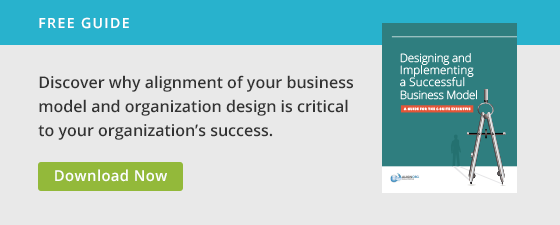In Part 1 of this article, we discussed the process of building organization design capability in change partners. Now, let’s examine the role of the Alignment Leader® in organization design, and learn how to assist an Alignment Leader in building organization design capability.
Why Alignment Leaders Need Organization Design Skills
To remain viable, an organization must change in ways that allow it to maintain resiliency and stay competitive in the market. Leaders must develop organization design capability to pilot the company through changes and respond to shifting internal and external conditions.
In contrast to the practical, hands-on role of the change partner, the role of Alignment Leader is visionary in nature. The Alignment Leader needs to first recognize where there is misalignment in their organization. This leads to a diagnosis, an assessment of the problem and an exploration of potential solutions. Once the new direction is identified, the leader needs to tee up the organization to address the misalignment. This may call for sponsoring a large-scale change effort. The leader must then sanction the work to be done and make sure the right resources are available to carry it out. It is critical that leaders have a solid understanding of organization design and what it means to be an Alignment Leader. They can use this knowledge to make decisions that support the entire organization in working smoothly and efficiently together to achieve the desired change.
How to Develop Organization Design Capability in Alignment Leaders
Asking these four key questions will help ensure Alignment Leaders receive organization design training adequate to the situation.
- What do I want the Alignment Leader to be scaled up to accomplish? Do they need to take an active leadership role, act as a sponsor, or simply understand the change process? One must first recognize the role of the Alignment Leader as defined above. Then, choose appropriate trainings to help them develop a solid understanding of the overarching concepts and principles used to guide an organization (as opposed to the hands-on, how-to knowledge needed by the change partner.)
- How do we give them the skills? Next, one must keep in mind that time is typically the Alignment Leader’s most scarce and precious resource. Choose methods that allow the leader to quickly develop a thorough understanding of organization design principles and skills. Often, this takes the form of an executive seminar to describe organization design concepts and their implications. We’ve also seen positive results with mixed groups of executives who share their organization transformation situations and discuss them with peers. Selected reading can help accelerate the learning curve.
- Who will be available to work with them? Will they have a change partner such as an HR partner, or will they be working by themselves? Will they hire an external consultant? What other help will be available to them? Wherever a resource comes from, having a mentor or thought partner is key.
- How do we help them to master those skills? In what ways can we support the Alignment Leader to develop their capability in the post-training period? This requires finding ways for leaders to test out their skills and leadership capabilities. From a succession planning perspective, this might be a special assignment to lead a strategic change initiative or an externally supported organizational change. From these experiences, Alignment Leaders can gain important in-the-trenches know-how that will help them in future organizational transformations.
Designing For Success
In Part 1 of this article, we explored the role of the change partner. Similarly, an Alignment Leader who knows how to drive organization transformation work is a powerful force in achieving marketplace success. When Alignment Leaders and change partners gain organization design capability, they become more effective, and results typically follow.







